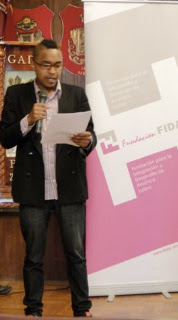For example, my own research and experience (or a cursory glance at any major media outlet) paints a vivid yet all-too familiar picture: a president who rode into the Palacio del Gobierno on a swell of support from the poor and historically marginalized groups who were to receive, at long last, a seat at the negotiating table. Once in office, however, Mr. Correa surged ahead with his own agenda and about sidelining dissenting voices, attempting legal action against opposition media outlets and branding indigenous organizers as obstructionists who wished, above all, to frustrate Ecuador's entry into the 21st century. Almost overnight, those whose struggles Candidate Correa venerated had become political enemies whom President Correa vilified. What social and political strides indigenous organizations like CONAIE have made ring somewhat hollow when we consider the economic dimension: "Indigenous" and "Poor" are two demographic indicators with a strong correlation. The country has problems, I don't mind telling you. But I'm going to tell a little story- one that, for me, put everything we had learned and seen into excellent perspective and provided an excellent bookend for the program. If you'd be so kind as to accompany me, or, as they say on the Presidential Palace tour "Sigan, por favor, tengan la bondad..."
...the afternoon had gone as many others before it-- fantastic lunch, museum tours, impromptu games of chicken against taxis in the Centro Historico with which Profe was none too impressed. We entered the magnificent Casa Gangotena boutique hotel just off the Plaza de San Francisco in the historic district and sat down for fresh jugo while we waited to meet our gracious host: Casa Gangotena's owner, one-time Quito mayor, and ecotourism magnate Roque Sevilla. Over juice, coffee, and hors d'oeuvres, Mr. Sevilla regaled us with tales of how his various ventures came into existence and what direction the ecotourism industry may take (turns out it is possible to run an eco-lodge where you never have to touch an insect.) He continued with a self-effacing account of the eruption of the Pichincha volcano just west of Quito during his tenure as mayor, and gave us the inside track on automobile admissions standards in Ecuador.

Late in the conversation, over the course of giving answers to several of our questions, Roque turned to comparisons between this country and the United States. More specifically, he contrasted the sometimes bullheaded manner of the Correa administration with something a little bit more familiar to us: United States Politics. He couldn't understand, for the life of him, why a country whose people had been behind so many of the innovations that have made the last two centuries what they were suddenly seemed lost in a morass of stubbornness, can't-do spirit, and social movements that, once in motion, seemed to go nowhere. We brainstormed over the myriad reasons why Occupy Wall Street (or DC, or Oakland, or pick a city) had failed, or at least stalled. We contrasted the failure of the electric car due to political, industry and consumer inertia with Ecuador's ambitious plan for rising fuel efficiency standards. And we lamented the reluctance of many of our leaders to risk re-election by actually making the progress they avowedly believed in. And just then, something clicked in my head. For all of its many problems, the current mindset in Ecuador still seems to be that hey, we can get. stuff. done. Diversity actually seems like something that people (avowedly) appreciate, and really believe will result in better decisions, even though it might take far longer. Rural communities don't have to simply put up with the harmful effects of large-scale mining operations just because the mining companies and the governments (sometimes) supporting them are powerful. They can mobilize, be heard, and get results. No, not everything will get done, and many things will seem much better on paper than they will actually turn out. But the belief, the will, is there, and sometimes I think that the U.S. has lost sight of that will. Granted, any compare/contrast between two so vastly dissimilar countries is going to be hugely inadequate, and neither do I have an ear to the ground in the Palacio to really, really know what's going on. Still, ensconced as it is in the omnipresent Buen Vivir, the politics and zeitgeist of Ecuador provides a few points on life in the 21st century which could, I think, serve as examples for many other, more "advanced" places in the world.
Or maybe I'm just jazzed from all that maté de coca.
























